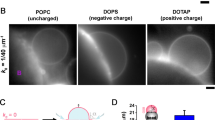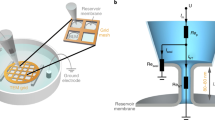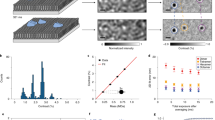Abstract
A complete understanding of the molecular mechanisms governing vesicle formation requires quantitative assays and vesicle reconstitution using purified components. We describe a simple model membrane template for studying protein-mediated membrane remodeling and vesicle formation or fission that is amenable to both quantitative biochemical analysis and real-time imaging by epifluorescence microscopy. Supported bilayers with excess membrane reservoir (SUPER) templates are compositionally well-defined unilamellar membrane systems prepared on 2–5-μm silica beads under conditions that enable incorporation of excess membrane to form a loosely fitting bilayer that can be used to study membrane remodeling and fission. This protocol describes methods for SUPER template formation and characterization, as well as for the qualitative observation and quantitative measurement of vesicle formation and fission via microscopy and a simple sedimentation assay. SUPER templates can be prepared within 60 min. Results from either sedimentation-based or microscopy-based assays can be obtained within an additional 60 min.
This is a preview of subscription content, access via your institution
Access options
Subscribe to this journal
Receive 12 print issues and online access
$259.00 per year
only $21.58 per issue
Buy this article
- Purchase on Springer Link
- Instant access to full article PDF
Prices may be subject to local taxes which are calculated during checkout






Similar content being viewed by others
References
Liu, A.P. & Fletcher, D.A. Biology under construction: in vitro reconstitution of cellular function. Nat. Rev. Mol. Cell Biol. 10, 644–650 (2009).
Mettlen, M., Pucadyil, T., Ramachandran, R. & Schmid, S.L. Dissecting dynamin's role in clathrin-mediated endocytosis. Biochem. Soc. Trans. 37, 1022–1026 (2009).
Schmid, S.L. & Frolov, V.A. Dynamin: functional design of a membrane fission catalyst. Annu. Rev. Cell Dev. Biol. 27, 79–105 (2011).
Conner, S.D. & Schmid, S.L. Regulated portals of entry into the cell. Nature 422, 37–44 (2003).
Ramachandran, R. et al. Membrane insertion of the pleckstrin homology domain variable loop 1 is critical for dynamin-catalyzed vesicle scission. Mol. Biol. Cell. 20, 4630–4639 (2009).
Pucadyil, T.J. & Schmid, S.L. Real-time visualization of dynamin-catalyzed membrane fission and vesicle release. Cell 135, 1263–1275 (2008).
Liu, Y.W. et al. Differential curvature sensing and generating activities of dynamin isoforms provide opportunities for tissue-specific regulation. Proc. Natl. Acad. Sci. USA 108, E234–E242 (2011).
Jakobsson, J. et al. Regulation of synaptic vesicle budding and dynamin function by an EHD ATPase. J. Neurosci. 31, 13972–13980 (2011).
Neumann, S. & Schmid, S. Regulation of dynamin-mediated fission by endocytic accessory proteins. Abstract no. 1030. in Mol. Biol. Cell 22, 4705 (2011).
Pucadyil, T.J. & Schmid, S.L. Supported bilayers with excess membrane reservoir: a template for reconstituting membrane budding and fission. Biophys. J. 99, 517–525 (2010).
Schmid, E.M. & McMahon, H.T. Integrating molecular and network biology to decode endocytosis. Nature 448, 883–888 (2007).
Schmid, S.L. & Smythe, E. Stage-specific assays for coated pit formation and coated vesicle budding in vitro. J. Cell Biol. 114, 869–880 (1991).
Miwako, I. & Schmid, S.L. Clathrin-coated vesicle formation from isolated plasma membranes. Methods Enzymol. 404, 503–511 (2005).
Takei, K. et al. Generation of coated intermediates of clathrin-mediated endocytosis on protein-free liposomes. Cell 94, 131–141 (1998).
Dannhauser, P.N. & Ungewickell, E.J. Reconstitution of clathrin-coated bud and vesicle formation with minimal components. Nat. Cell Biol. 14, 634–639 (2012).
Ford, M.G. et al. Simultaneous binding of PtdIns(4,5)P2 and clathrin by AP180 in the nucleation of clathrin lattices on membranes. Science 291, 1051–1055 (2001).
Sweitzer, S. & Hinshaw, J. Dynamin undergoes a GTP-dependent conformational change causing vesiculation. Cell 93, 1021–1029 (1998).
Takei, K., Slepnev, V.I. & De Camilli, P. Interactions of dynamin and amphiphysin with liposomes. Methods Enzymol. 329, 478–486 (2001).
Danino, D., Moon, K.H. & Hinshaw, J.E. Rapid constriction of lipid bilayers by the mechanochemical enzyme dynamin. J. Struct. Biol. 147, 259–267 (2004).
Gallop, J.L. et al. Mechanism of endophilin N-BAR domain-mediated membrane curvature. EMBO J. 25, 2898–2910 (2006).
Peter, B.J. et al. BAR domains as sensors of membrane curvature: the amphiphysin BAR structure. Science 303, 495–499 (2004).
Pylypenko, O., Lundmark, R., Rasmuson, E., Carlsson, S.R. & Rak, A. The PX-BAR membrane-remodeling unit of sorting nexin 9. EMBO J. 26, 4788–4800 (2007).
Ford, M.G. et al. Curvature of clathrin-coated pits driven by epsin. Nature 419, 361–366 (2002).
Roux, A. et al. Membrane curvature controls dynamin polymerization. Proc. Natl. Acad. Sci. USA 107, 4141–4146 (2010).
Roux, A., Uyhazi, K., Frost, A. & De Camilli, P. GTP-dependent twisting of dynamin implicates constriction and tension in membrane fission. Nature 441, 528–531 (2006).
Bashkirov, P.V. et al. GTPase cycle of dynamin is coupled to membrane squeeze and release, leading to spontaneous fission. Cell 135, 1276–1286 (2008).
Weber, T. et al. SNAREpins: minimal machinery for membrane fusion. Cell 92, 759–772 (1998).
Karatekin, E. et al. A fast, single-vesicle fusion assay mimics physiological SNARE requirements. Proc. Natl. Acad. Sci. USA 107, 3517–3521 (2010).
Leonard, M., Song, B.D., Ramachandran, R. & Schmid, S.L. Robust colorimetric assays for dynamin's basal and stimulated GTPase activities. Methods Enzymol. 404, 490–503 (2005).
Acknowledgements
This work was funded by the US National Institutes of Health grants R01-GM42455 and R01-MH61345 to S.L.S. and fellowships from the Leukemia and Lymphoma Society to T.J.P. and from the German Research Foundation (DFG) and the American Heart Association to S.N. We thank Y.-W. Liu for her help in filming the procedures and M. Dadachov at Corpuscular for helpful discussions regarding silica bead preparation.
Author information
Authors and Affiliations
Contributions
T.J.P. developed the method and provided comments on the manuscript. S.N. developed the detailed protocol and troubleshooting steps and wrote the manuscript with S.L.S.
Corresponding author
Ethics declarations
Competing interests
The authors declare no competing financial interests.
Supplementary information
Supplementary Video 1
Membrane spill. For quality control of the SUPER templates, they can be transferred into a droplet of buffer on a clean, uncoated coverslip. As the templates come into contact with the glass surface, the excess membrane will expand away from the bead forming a supported bilayer that surrounds it. (MOV 462 kb)
Supplementary Video 2
Addition of SUPER templates to the reaction mixture for the sedimentation assay. Demonstration on how SUPER templates should be pipetted into the reaction mixture to avoid release of vesicles by shearing of the reservoir during the sedimentation assay. (MOV 1791 kb)
Supplementary Video 3
Real-time imaging of fission. Due to their large size SUPER templates are amenable to the real-time monitoring of protein-mediated membrane remodeling by fluorescence microscopy. SUPER templates were dispersed and allowed to settle in assay buffer containing an oxygen-scavenging system and 1 mM GTP. After imaging was started, dynamin-1 was added to the solution with a pipette to a final concentration of 0.5 μM. The movie is composed of frames captured via 100 ms exposures at 1-s intervals and is played at 7 frames/s speed. (MOV 2429 kb)
Supplementary Video 4
Preparation of membrane tethers. Demonstration of how the Lab-Tek chamber is tilted to achieve formation of membrane tethers. (MOV 4728 kb)
Supplementary Video 5
Fission of membrane tethers. SUPER templates were dispersed and allowed to settle in assay buffer containing an oxygen-scavenging system and 1 mM GTP. Plain silica beads (d = 20 μm) were added to the solution onto one side of the chamber and allowed to settle. Tethers were pulled by tilting the chamber and rolling the large beads over the layer of SUPER templates. After imaging was started, dynamin-1 was added to the solution with a pipette to a final concentration of 0.5 μM. The movie is composed frames captured via 100 ms exposures at 1-s intervals and is played at 1 frame/s speed. (MOV 233 kb)
Rights and permissions
About this article
Cite this article
Neumann, S., Pucadyil, T. & Schmid, S. Analyzing membrane remodeling and fission using supported bilayers with excess membrane reservoir. Nat Protoc 8, 213–222 (2013). https://doi.org/10.1038/nprot.2012.152
Published:
Issue Date:
DOI: https://doi.org/10.1038/nprot.2012.152
This article is cited by
-
Mechanochemical feedback loop drives persistent motion of liposomes
Nature Physics (2023)
-
Protein–Protein Interactions on Membrane Surfaces Analysed Using Pull-Downs with Supported Bilayers on Silica Beads
The Journal of Membrane Biology (2022)
-
Combining patch-clamping and fluorescence microscopy for quantitative reconstitution of cellular membrane processes with Giant Suspended Bilayers
Scientific Reports (2019)
-
A novel fluorescence microscopic approach to quantitatively analyse protein-induced membrane remodelling
Journal of Biosciences (2018)
-
Human ATG3 binding to lipid bilayers: role of lipid geometry, and electric charge
Scientific Reports (2017)
Comments
By submitting a comment you agree to abide by our Terms and Community Guidelines. If you find something abusive or that does not comply with our terms or guidelines please flag it as inappropriate.



